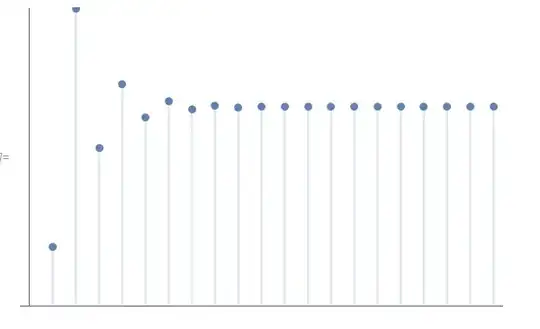I'm doing Problem II.4.6 in textbook Analysis I by Amann/Escher.
For $x_0,x_1 \in \mathbb R^+$, the sequence $(x_n)_{n \in \mathbb N}$ defined recursively by $x_{n+2} = \sqrt{x_{n+1} x_n}$ is convergent.
My questions:
- I'm not sure if my attempt (the parts from Lemma 4 to the end) is fine or contains logical gaps/errors. Could you please verify these parts? Any suggestion is greatly appreciated.
Particularly, I'm not sure if my induction in case $m > n$ in the part "...$\color{blue}{\text{vacuously true}}$ ..." and the proof that there exists $0 < \beta < 1$ such that $y_{n+1} \le \beta y_n$ are correct or not.
- There is Problem II.4.5 as follows:
For $z_0,a \in \mathbb R^+$ , the sequence $(z_n)_{n \in \mathbb N}$ defined recursively by $z_{n+1}=a/(1+z_n)$ is convergent.
Using Mathematica, I found that both of the sequences $(x_n)_{n \in \mathbb N}$ and $(z_n)_{n \in \mathbb N}$ share the same plot as follows.
I would like to ask whether it is possible to utilize the convergence of $(z_n)_{n \in \mathbb N}$ to prove the convergence of $(x_n)_{n \in \mathbb N}$.
Thank you so much for your help!
My attempt:
First we consider the case $x_0 < x_1$.
Lemma 1: $x_{2n} < x_{2n+1}$ for all $n$.
Proof: The statement trivially holds for $n=0$. Let it hold for some $n$. We have $$\begin{aligned} x_{2(n+1)} < x_{2(n+1)+1} & \iff x_{2n+2} < x_{2n+3} \\ &\iff \sqrt{x_{2n+1} x_{2n}} < \sqrt{x_{2n+2} x_{2n+1}} \\ &\iff x_{2n} < x_{2n+2} \\ &\iff x_{2n} < \sqrt{x_{2n+1} x_{2n}} \\&\iff x_{2n} < x_{2n+1}\quad (\star) \end{aligned}$$ in which $(\star)$ follows from inductive hypothesis. As such, the statement holds for $n+1$.
Lemma 2: $x_{2n} < x_{2n+2}$ for all $n$.
Proof: We have $x_{2n} < x_{2n+2} \iff x_{2n} < \sqrt{x_{2n+1} x_{2n}} \iff x_{2n} < x_{2n+1}$, which is true by Lemma 1. As a consequence, $(x_{2n})_{n \in \mathbb N}$ is increasing.
Lemma 3: $x_{2n+3} < x_{2n+1}$ for all $n$.
Proof: We have $x_{2n+3} < x_{2n+1} \iff \sqrt{x_{2n+2} x_{2n+1}} < x_{2n+1} \iff x_{2n+2} < x_{2n+1} \iff$ $\sqrt{x_{2n+1} x_{2n}} < x_{2n+1} \iff x_{2n} < x_{2n+1}$, which is true by Lemma 1. As a consequence, $(x_{2n+1})_{n \in \mathbb N}$ is decreasing.
Lemma 4: $x_{2m} < x_{2n+1}$ for all $m,n$.
Proof: In case $m \le n$, we have $x_{2m} \overset{(\star)}{\le} x_{2n} \overset{(\star\star)}{<} x_{2n+1}$ in which $(\star)$ follows from the fact that $(x_{2n})_{n \in \mathbb N}$ is increasing, and $(\star\star)$ follows from Lemma 1.
We prove the statement in case $m > n$ by induction on $m$. It's $\color{blue}{\text{vacuously true}}$ for $m=0$. Let it hold for some $m$. We have $$\begin{aligned} x_{2(m+1)} < x_{2n+1} & \iff x_{2m+2} < x_{2n+1} \\ &\iff \sqrt{x_{2m+1} x_{2m}} < x_{2n+1} \\ &\iff x_{2m+1} x_{2m} < x^2_{2n+1} \quad (\star) \end{aligned}$$ in which $(\star)$ follows from $x_{2m} < x_{2n+1}$ (by inductive hypothesis) and from $x_{2m+1} < x_{2n+1}$ (by $m > n$ and $(x_{2n+1})_{n \in \mathbb N}$ is decreasing). As such, the statement holds for $n+1$.
We define the sequence $(y_n)$ by $y_n := x_{2n+1} - x_{2n}$. We next prove that there exists $0 < \beta < 1$ such that $y_{n+1} \le \beta y_n$ for all $n$.
$$\begin{aligned} y_{n+1} < \beta y_n &\iff x_{2(n+1)+1} - x_{2(n+1)} < \beta (x_{2n+1} - x_{2n}) \\ &\iff x_{2n+3} - x_{2n+2} < \beta (x_{2n+1} - x_{2n}) \\&\iff \sqrt{x_{2n+2} x_{2n+1}} - x_{2n+2} < \beta (x_{2n+1} - x_{2n}) \\ &\iff \sqrt{x_{2n+2}} (\sqrt{x_{2n+1}} - \sqrt{x_{2n+2}}) < \beta (x_{2n+1} - x_{2n})\end{aligned}$$
Since $x_{2n+2} > x_{2n}$, $\sqrt{x_{2n+1}} - \sqrt{x_{2n+2}} < \sqrt{x_{2n+1}} - \sqrt{x_{2n}}$. As such, it suffices to prove that there exists $0 < \beta < 1$ such that $\sqrt{x_{2n+2}} (\sqrt{x_{2n+1}} - \sqrt{x_{2n}}) < \beta (x_{2n+1} - x_{2n})$. We have
$$\begin{aligned} &\sqrt{x_{2n+2}} (\sqrt{x_{2n+1}} - \sqrt{x_{2n}}) < \beta (x_{2n+1} - x_{2n}) \\ &\iff \sqrt{x_{2n+2}} < \beta (\sqrt{x_{2n+1}} + \sqrt{x_{2n}}) \\ &\iff \dfrac{\sqrt{x_{2n+2}}}{\sqrt{x_{2n+1}} + \sqrt{x_{2n}}} < \beta \\&\iff \left( \dfrac{\sqrt{x_{2n+2}}}{\sqrt{x_{2n+1}} + \sqrt{x_{2n}}}\right)^2 < \beta^2 \\ &\iff \dfrac{x_{2n+2}}{x_{2n+1} + 2\sqrt{x_{2n+1} x_{2n}} + x_{2n}} < \beta^2 \\ &\iff \dfrac{x_{2n+2}}{x_{2n+1} + 2x_{2n+2} + x_{2n}} < \beta^2\\ &\iff \dfrac{1}{2+ x_{2n+1}/x_{2n+2} + x_{2n}/x_{2n+2}} < \beta^2 \end{aligned}$$
As a result, we are done if we choose $1/\sqrt{2} <\beta < 1$. Then $y_{n+1} \le \beta y_n$ and thus $y_{n} \le \beta^n y_0$ for all $n$. We have $0 \le \lim_{n \to \infty} y_n \le \lim_{n \to \infty} \beta^n y_0 = 0$. As such, $\lim_{n \to \infty} y_n = 0$ and so $\lim_{n \to \infty}x_{2n} = \lim_{n \to \infty}x_{2n+1} = \alpha$.
From Lemmas 2,3, and 4, our sequence $(x_n)_{n \in \mathbb N}$ looks like $$x_0 < x_2 < x_4 < \cdots < x_{2n}< \cdots <x_{2n+1} < \cdots <x_5<x_3<x_1$$
By Nested Intervals Theorem, we have $$\lim_{n \to \infty}x_{2n} = \lim_{n \to \infty}x_{2n+1}$$
Next we prove that $$\lim_{n \to \infty}x_{n} = \alpha$$
Approach 1: For $\varepsilon > 0$, there exists $N \in \mathbb N$ such that $|x_{2n} - \alpha| < \varepsilon$ and $|x_{2n+1} - \alpha| < \varepsilon$ for all $n > N$. Thus $|x_{n} - \alpha| < \varepsilon$ for all $n > 2N$. As a result, $\lim_{n \to \infty}x_{n} = \alpha$.
Approach 2:
Given $n \in \mathbb N$, we have $A := \{2k+1 \in \mathbb N \mid k \ge n\} \subseteq B := \{k \in \mathbb N \mid k \ge n\}$ and, for each $k \in B$, there exists $k' \in A$ such that $x_k \le x_{k'}$. As such, $\sup_{k \ge n} x_{k} = \sup_{k \ge n} x_{2k+1}$ and thus $\inf_{n \ge 0} \sup_{k \ge n} x_{k} = \inf_{n \ge 0} \sup_{k \ge n} x_{2k+1}$. Similarly, we have $\sup_{n \ge 0} \inf_{k \ge n} x_{2k} =$ $\sup_{n \ge 0} \inf_{k \ge n} x_{k}$. It follows that $$\alpha = \sup_{n \ge 0} \inf_{k \ge n} x_{2k} = \sup_{n \ge 0} \inf_{k \ge n} x_{k} \le \inf_{n \ge 0} \sup_{k \ge n} x_{k} = \inf_{n \ge 0} \sup_{k \ge n} x_{2k+1} = \alpha$$ and thus $\lim_{n \to \infty} x_{n} = \alpha$.
The case $x_0 > x_1$ is similar, while the case $x_0 = x_1$ is trivial.
